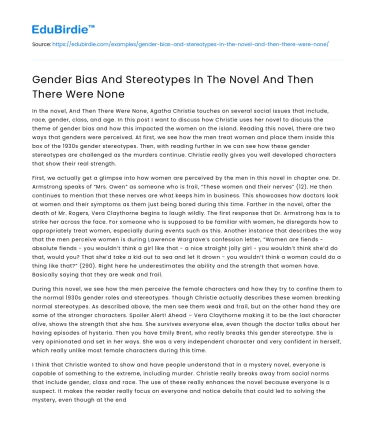In the novel, And Then There Were None, Agatha Christie touches on several social issues that include, race, gender, class, and age. In this post I want to discuss how Christie uses her novel to discuss the theme of gender bias and how this impacted the women on the island. Reading this novel, there are two ways that genders were perceived. At first, we see how the men treat women and place them inside this box of the 1930s gender stereotypes. Then, with reading further in we can see how these gender stereotypes are challenged as the murders continue. Christie really gives you well developed characters that show their real strength.
First, we actually get a glimpse into how women are perceived by the men in this novel in chapter one. Dr. Armstrong speaks of “Mrs. Owen” as someone who is frail, “These women and their nerves” (12). He then continues to mention that these nerves are what keeps him in business. This showcases how doctors look at women and their symptoms as them just being bored during this time. Farther in the novel, after the death of Mr. Rogers, Vera Claythorne begins to laugh wildly. The first response that Dr. Armstrong has is to strike her across the face. For someone who is supposed to be familiar with women, he disregards how to appropriately treat women, especially during events such as this. Another instance that describes the way that the men perceive women is during Lawrence Wargrave’s confession letter, “Women are fiends - absolute fiends - you wouldn’t think a girl like that - a nice straight jolly girl - you wouldn’t think she’d do that, would you? That she’d take a kid out to sea and let it drown - you wouldn’t think a woman could do a thing like that?” (290). Right here he underestimates the ability and the strength that women have. Basically saying that they are weak and frail.
Save your time!
We can take care of your essay
- Proper editing and formatting
- Free revision, title page, and bibliography
- Flexible prices and money-back guarantee
During this novel, we see how the men perceive the female characters and how they try to confine them to the normal 1930s gender roles and stereotypes. Though Christie actually describes these women breaking normal stereotypes. As described above, the men see them weak and frail, but on the other hand they are some of the stronger characters. Spoiler Alert! Ahead – Vera Claythorne making it to be the last character alive, shows the strength that she has. She survives everyone else, even though the doctor talks about her having episodes of hysteria. Then you have Emily Brent, who really breaks this gender stereotype. She is very opinionated and set in her ways. She was a very independent character and very confident in herself, which really unlike most female characters during this time.
I think that Christie wanted to show and have people understand that in a mystery novel, everyone is capable of something to the extreme, including murder. Christie really breaks away from social norms that include gender, class and race. The use of these really enhances the novel because everyone is a suspect. It makes the reader really focus on everyone and notice details that could led to solving the mystery, even though at the end we find that we would have never solved this one.






 Stuck on your essay?
Stuck on your essay?

